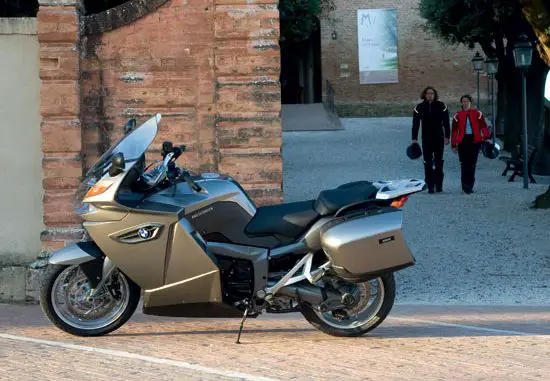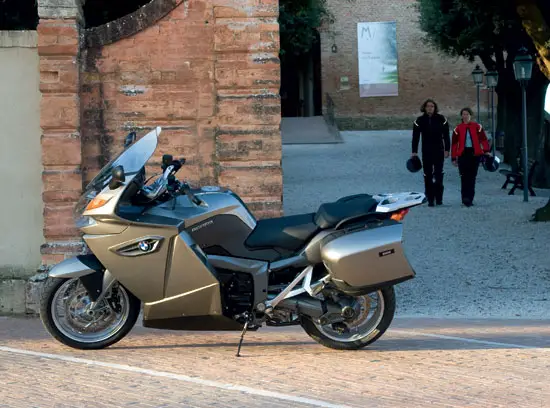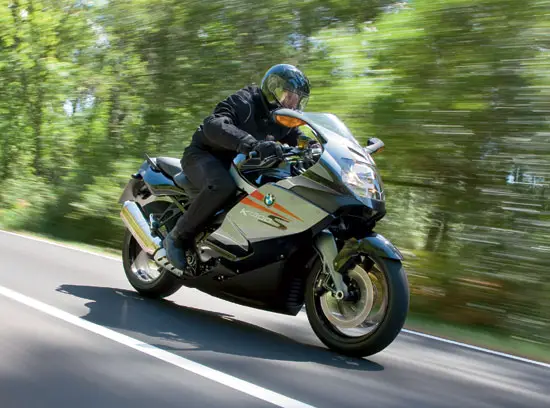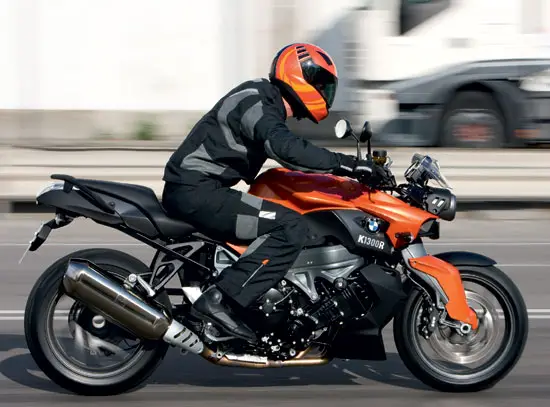
You are here: Home — 2009 Models — 2009 BMW Motorcycle Models
25 Years of BMW K-Series
Back to 2009 BMW Motorcycle Index Page
Click photos to enlarge.
They make great desktop images.
– 25 Years of BMW K-Series
25 Years of BMW K-Series
The BMW Inline-Engine.
Back in 1983, when many motorcycle manufacturers still placed their bets on
inline engines with air cooling, liquid-cooled four-cylinder power units marked
the highest level of technology in motorcycle construction. But instead of
resorting to the usual engine layouts, BMW engineers Josef Fritzenwenger
and Stefan Pachernegg succeeded in developing a brand-new future-oriented
technical concept subsequently enhanced all the way to regular production
quality.
In the process they maintained the longitudinal position of the crankshaft
typical up to that time of BMW motorcycles with a direct fl ow of power from
the gearbox through the drive shaft to the rear wheel, referred to under
the offi cial term as the BMW Compact Drive System. A brand-new approach,
on the other hand, was the introduction of liquid cooling.
Displacing 987 cc, the straight-four power unit is fi tted in longitudinal, fl at
confi guration. The crankshaft is on the right-hand side seen in the direction
of travel, while the cylinder head with the two overhead camshaft is on the left.
Liquid cooling comes for the fi rst time on this new BMW, ensuring not only
supreme thermal stability, but also, through effi cient soundproofi ng, a very low
level of mechanical noise.
Two other innovations likewise characterised the new engine: First, electronic
fuel injection supplying fuel to the combustion chambers. Second, the
layout of the engine as a load-bearing element fully integrated in the light and
torsionally stiff tubular steel spaceframe.
This principle sets the foundation for the BMW K-Series motorcycles. So
regardless of whether they are Sports Machines, Tourers or Naked Bikes –
the K-Series proves to be extremely innovative and versatile in technical terms
and virtually every other respect. To this day, the concept of the straight-four
fi tted lengthwise remains within the BMW Motorrad model range in the guise
of the K 1200 LT Luxury Tourer.
Ongoing development of the K-Series also provides important momentum
for a brand-new technical approach. In 2004, for example, the fi rst
BMW K Series with its four-cylinder engine fi tted crosswise sees the light
of day – the K 1200 S as the most powerful and fastest BMW of all times.
Just how much development margin and what a great potential this new
concept offers in the K-Series is subsequently borne out not only by the
new K 1200 R High-Performance Roadster based on the new sports model,
but also by the K 1200 GT High Performance Tourer.
Increasing engine size on these models and introducing new, innovative
solutions, BMW Motorrad is now opening up another, defi nitely equally
successful chapter in the history of the Company’s K models.
K 100 (1983–1990).
The K 100 launched in 1983 – exactly six decades after the launch of the very
fi rst BMW motorcycle with its Boxer engine – is BMW’s fi rst production model
with a four-cylinder power unit. But instead of following the usual Japanese
concept with the straight-four engine fi tted crosswise, BMW once again takes
a new and unusual approach: Featuring liquid-cooling and not air-cooling
like most other production motorcycles, the four-cylinder power unit is fi tted
fl at in longitudinal direction as a load-bearing element in the tubular steel
spaceframe, with the transmission of power from the gearbox to the rear
wheel remaining in a technology so typical and well-proven at BMW: through
a drive shaft.
The K 100 is one of the fi rst production motorcycles in the world to feature
fuel injection (Bosch LE-Jetronic) supplying the fuel/air mixture to the 987-cc
four-cylinder with two valve-operated cup tappets per cylinder.
Two other innovations in the production of BMW series machines are the
two overhead camshafts as well as the Monolever single-swing arm on these
dynamic 1000-cc models.
BMW’s fi rst-ever four-cylinder is upgraded in 1987, a free-standing headlight
taking the place of the former headlight/instrument unit, a black-painted
engine and painted rims as well as a dynamically style fuel tank/seat
combination marking the most important differences.
As before, engine output is 90 hp at 8,000 rpm.
K 100 RS (1983–1989).
Introducing the K 100 RS, BMW adds a sports model to the existing range
with the same engine and suspension technology, but now featuring a
carefully designed aerodynamic fairing. The handlebar fi tted lower down
provides a more sporting seat position, the fairing carefully developed in the
wind tunnel, together with its adjustable wind defl ector and the direction
indicators integrated in the rear mirrors, combining a sporting look for high
speeds with all the grand touring comfort so typical of a BMW.
The Two-Valve Models as of 1983.
For a long time the K 100 RS remains the ideal synthesis of sportiness
and touring comfort and, with a production run of more than 34,000 units,
becomes the best-selling model in the fi rst generation of the K-Series.
BMW offers the K 100 RS as well as the other four-cylinder models in the
K-Series as of 1988 with ABS as a special feature, thus taking on the leading
role in introducing this technology in the motorcycle world.
K 100 RT (1984–1989).
In 1984 BMW Motorrad launches the ultimate Grand Touring Machine, the
K 100 RT based on the K 100 RS. Featuring the same engine and suspension
technology as the RS, this new model combines a sporting and dynamic
style of riding with perfect protection from wind and weather on long
distances provided by the higher and wider full fairing. The comfortable
seating position enjoyed by both the rider and pillion as well as a wide range
of BMW options and special equipment comprising, for example, baggage
cases, a tank rucksack or heated handles, quickly make the K 100 RT the
benchmark in its segment.
K 100 LT (1986–1991).
In 1986 BMW launches a luxury version of the successful K 100 RT, the new
K 100 LT. The response to this Grand Touring machine also featuring a
generously upholstered comfort seat, a radio, topcase and special paintwork
is so overwhelming that the K 100 LT soon outsells the K 100 RT “basic”
model in the market.
The new machine leaves virtually nothing to be desired in terms of comfort
and features, making this Luxury Tourer the role model for a whole new
generation of extravagant touring machines.
K 75 C/K 75 (1985 – 1996).
Two years after the launch of the K-Series with its four-cylinder power unit,
BMW broadens the new product line through the introduction of the K 75 C
with a straight-three engine. While the suspension and running gear is based
almost entirely on the innovative technology of the large four-cylinder,
the 740-cc power unit is a brand-new construction nevertheless following the
basic layout of the four-cylinder very closely indeed.
Again fi tted lengthwise and in fl at arrangement as a load-bearing element
in the spaceframe, this liquid-cooled three-cylinder with 67 millimetres/2.63“
cylinder bore and 70 millimetres/2.76“ stroke comes with the same basic
spec fi cations as the larger K 100.
The drive shaft positioned beneath the crankshaft gives the three-cylinder
particular smoothness and refi nement also thanks to the balance weights
used on the shaft. Developing maximum output of 75 hp on total weight with
a full tank of 227 kg/501 lb, the K 75 C stands out above all as a particularly
agile motorcycle for country roads, without requiring the rider to give up the
grand touring comfort so typical of a BMW.
Just one year after the launch of the K 75, the customer is given the choice
of a new alternative, the K 75 C with its cockpit fairing fi tted fi rmly to the
handlebar. Now the headlight and instruments are now longer integrated in
the cockpit fairing, but rather stand out freely on the machine, with the rear
drum brake in combination with the 18-inch rear wheel being replaced as of
1990 by a disc brake and a 17-inch rear wheel.
The engine fi nished in black and the dynamically designed fuel tank/seat
combination serve to further upgrade the K 75. Accounting for approximately
28,000 units, the two “basic” versions of the K 75 become the most
successful representatives of their model series.
K 75 S (1985–1995).
Introducing the K 75 S, BMW adds a sporting sister model to the K 75 C.
While the suspension and drivetrain are based on the innovative technology
of the K 75 C, the slender semi-shell bearing fi tted fi rmly to the frame clearly
reveals the sporting character of the motorcycle right from the beginning.
The K 75 S therefore also comes with a fi rmer spring/damper set-up featuring
shorter spring travel and a 17-inch rear wheel with a disc brake instead of
the full-hub drum brake on the basic model.
The K 75 S Special launched in 1986 boasts an engine spoiler introduced
as a standard feature in 1988.
As of 1990 the K 75 S, like all other three-cylinders, is likewise available
with ABS. And starting in the 1991 model year, three-spoke light-alloy wheels
take the place of the eight-spoke cast wheels used so far.
K 75 RT (1989–1996).
In 1989 BMW carries over the successful concept of the K 100 RT to the
three-cylinder model series, thus creating the K 75 RT. On this new model the
sophisticated aerodynamic full fairing offers outstanding protection from wind
and weather on long distances, while the wide range of optional extras and
special equipment so typical of BMW leaves nothing to be desired also on the
Tourer with its three-cylinder power unit.
On 18 March 1991 a K 75 RT comes off the production lines at BMW as
the one-millionth model built by BMW Motorrad.
Introducing two special models, the K 75 RT Ultima and the K 75 Ultima,
each in special paintwork, with ABS, a catalytic converter and case holders,
BMW fi nally ceases production of the three-cylinder model series in summer
1996 after a total production volume of the K 75 amounting to 68, 011 units.
K1 (1988–1993).
In 1988 the K1 sets another milestone in the history of the BMW K-Series.
Apart from its brand-new design and aerodynamics concept remaining unique
in the motorcycle world to this day, the K1 is BMW’s fi rst production motorcycle
with four-valve technology, small valve angles, and extremely advanced
design of the combustion chambers.
The greater cylinder charge achieved in this way is refl ected by the extra
power of the engine, the K1 developing maximum output of 100 hp at
8, 000 rpm – more than any other BMW before.
Featuring new Bosch Motronic fuel injection, 17-inch wheels and ABS, the
K1 also sets new highlights in technology, one example being the Paralever
double-joint rear wheel swing arm introduced a year before on the R 100 GS
and effectively preventing drive forces from the drive shaft and any undesired
effects of this kind on the rear-wheel suspension.
The K1 is also the world’s fi rst production machine to feature a fully-controlled
three-way catalytic converter, making a signifi cant contribution to
environmental protection and subsequently introduced step-by-step on
all BMW motorcycles as of 1991.
Production of the K1 ends in 1993 with the special Ultima model.
K 100 RS (1989–1992).
The innovative four-valve technology introduced on the K1 with its engine
output of 100 hp makes its way back into the market in 1989 in the highly
successful K 100 RS. While the combination of the fuel tank and seat as well
as the fairing with direction indicators integrated in the rear-view mirrors
corresponds to the former model, the new K 100 RS, like the K1, benefi ts
form new 17-inch wheels, larger brakes, and the Paralever single-swing arm
at the rear.
K 1100 LT (1991–1999).
In 1991 BMW presents yet another milestone in the history of the K-Series
through the introduction of the K 1100 LT, the fi rst BMW to displace
more than 1,000 cc: an increase in cylinder bore from 67 to 70.5 millimetres
(2.63 to 2.78”) gives the engine 105 cc more capacity, the upgraded K
The First-Generation Four-Valve Models.
four-cylinder developing maximum output of 100 hp from 1,092 cc at an
engine speed of only 7,500 rpm.
A factor far more important on the road than the increase in maximum output
by 10 hp over the former model is the sign fi cant increase in torque. Offering
a lot more traction and pulling power, the K 1100 LT is even more superior
on the road and for a long time represents the topmost level in the Luxury
Tourer market. This is also borne out clearly by the fundamentally upgraded
suspension with its Paralever single-swing arm effectively keeping out
any undesired disturbance from the drivetrain and thus ensuring even greater
comfort and riding smoothness.
Another important feature offered by the K 1100 LT for the fi rst time is the
electrically adjustable windshield. Newly developed cases and a special
topcase, fi nally, round off the well-conceived range of touring features again
so typical of BMW.
Launching the K 1100 LT Highline in 1997, BMW Motorrad introduces
a special model highlighting the luxurious claim of this supreme Tourer by
sophisticated chrome components and equally outstanding special paintwork.
K 1100 RS (1992–1996).
Just one year after introduction of the large four-cylinder in the K 1100 LT,
the same 100-hp power unit is featured in the LT’s sporting sister model, the
K 1100 RS. The newly designed fairing with its lower section encompassing
the engine ensures even better aerodynamic qualities and once
again optimises the protection of wind and weather so typical of BMW.
A new Marzocchi telescopic fork as well as the fi rmer suspension set-up
gives this sporting all-rounder even greater dynamic qualities.
A particularly sophisticated special model, the K 1100 RS with its polished
immersion tube, black-painted tank and upper fairing, as well as distinctive
elements fi nished in silver such as the cooling air intake, the lower section of
the fairing and the rear fairing, give this special model a very particular touch.
K 1200 RS (1996–2005).
The K 1200 RS launched in autumn 1996 takes yet another step in terms of
engine size and driving dynamics. A new crankshaft now offering 75 instead
of 70 millimetres (2.95 instead of 2.75”) stroke increases engine capacity
by exactly 79 cc to 1,171 cc, with power up from 100 to 130 hp at 8,750 rpm.
The new six-speed gearbox ensures even more dynamic performance and the
brand-new suspension clearly refl ects the sporting style of this new top-end
model.
For the fi rst time the K 1200 RS features a light-alloy bridge frame integrating
the four-cylinder power unit no longer as a load-bearing element, but rather as
a detached unit not conveying any vibration to the machine.
The K 1200 RS is the fi rst model in the K-Series to feature the unique frontwheel
Telelever originally introduced on the R 1100 RS in 1993. Individual
ergonomic preferences, fi nally, are taken into account by the option to adjust
the handlebar, the windshield, the footrests and the seat (for height).
K 1200 LT (1998–2008).
Two years after the introduction of the K 1200 RS, BMW presents a particularly
luxurious Tourer in the guise of the K 1200 LT, leaving all conventional
standards and models far behind. Based on the suspension and engine technology
of the K 1200 RS, the K 1200 LT also features a new light-alloy bridge
frame as well as an increase in capacity to 1,171 cc.
Offering maximum output of 98 hp at just 6,750 rpm and peak torque of
115 Newton-metres (85 lb-ft) at a low 4,750 rpm, the K 1200 LT is designed
less for peak performance than rather for supreme torque and pulling power.
Hence, it only needs a fi ve-speed gearbox for superior touring in genuine
style.
Apart from the full fairing offering perfect protection from wind and weather,
as well as cases integrated in the overall design and layout of the machine and
a topcase offering a total capacity of 120 litres, the K 1200 LT, with its HiFi
player, on-board computer, cruise control, heated handles and optionally
heated seat offers touring comfort of a standard never seen before.
This wide range of equipment explains the sign fi cant overall weight of 378 kg
or 833 lb, which BMW also takes into account by adding a reverse gear for
practical manoeuvring activated electrically by the starter motor.
The K 1200 LT is further upgraded in the 2004 model year, now benefi ting
from an even more powerful engine with 116 hp and 120 Newton-metres
(88 lb-ft) maximum torque, an electrohydraulically activated main stand and
a rear spring element with travel-dependent damping.
To this day, the K 1200 Lt comes right at the top of this market segment.
K 1200 GT (2002–2005).
The K 1200 GT makes its debut in 2002 as an enhanced variant of the
K 1200 RS giving even greater emphasis to touring comfort. Boasting 130 hp
maximum output, featuring a higher windshield and handlebar, optimised
seating comfort and a case system fi tted as standard, the K 1200 GT is even
more of a genuine Gran Turismo, redefi ning the synthesis of sporting riding
dynamics and supreme touring comfort in BMW’s usual style and quality. The
outstanding aerodynamic benefi ts offered by the full fairing ensure not only
optimum protection from wind and weather, but also, in conjunction with a
powerful engine, guarantee high average speeds on long distances.
K 1200 S (2004–2008).
The K 1200 S makes its entry into the market in 2004 as a radically new and
highly innovative Sports Machine standing out as a unique model within the
K-family. With its brand-new straight-four now fi tted crosswise and displacing
1,157 cc, the K 1200 S has no predecessor and no role model in the history of
BMW Motorrad, but is rather brand-new in every respect.
The technical highlights of this 167-hp Sports Machine are the very sloped
angle of the cylinder bank tilted 55o to the front to provide a low centre of
gravity as well as innovative suspension technology with the BMW EVO Paralever
and the BMW Duolever at the front. On the BMW Duolever, the square
set-up of arms consisting of two longitudinal arms pivoting within the frame
guides the wheel bearings and thus allows appropriate wheel travel.
The K 1200 S combines supreme riding precision and agility with a standard
of engine power and riding performance that leaves nothing to be desired.
As an option BMW even offers ESA (Electronic Suspension Adjustment) on
the K 1200 S for the fi rst time in series production, electronically controlled
suspension operated at the touch of a button. This allows the rider to adjust
the suspension and damping individually to his personal style and the load
the machine is carrying.
K 1200 R (2004–2008).
Launching the high-performance K 1200 R Roadster, BMW enters the
segment of high-power Naked Bikes for the fi rst time in 2004. Based on the
K 1200 S, the new K 1200 R benefi ts from the straight-four engine with
dry sump lubrication as well as innovative suspension technology with the
BMW Duolever at the front and the BMW EVO Paralever at the rear.
Developing 163 hp at 10, 250 rpm, the K 1200 R is almost as powerful as the
sports model with its special fairing, immediately moving to the top in the
Naked Bikes segment.
The new Roadster also bears out its superior performance through the special
look of this new machine. Special body elements around the tank and rear end
as well as the striking dual headlight with its surface fi nished in matt chrome
The Second-Generation of Four-Cylinders.
Only a small windshield covers the front area above the
headlight, but still offers effi cient protection from the wind rushing by despite
its small size.
Fitted with racing tyres, carbon trim and other motorsport components,
the K 1200 R hits the headlines in the BMW Motorrad Power Cup held on
the occasion of the MotoGP races in 2005.
K 1200 GT (2006–2008).
Following the success of its predecessor of the same name, the K 1200 GT
opens up new dimension in riding dynamics and long-distance touring in
2006, combining maximum agility and dynamics in an overall package equally
well suited for superior touring. To reach this objective the development
engineers at BMW Motorrad carry over the trendsetting suspension and
engine technology of the K 1200 S into this new Sports Tourer, the innovative
wheel guidance components – the Duolever and the EVO Paralever at the
rear – making a signifi cant contribution to the very dynamic riding qualities of
the K 1200 GT.
The new machine is powered by BMW Motorrad’s ultra-modern straight-four
power unit fi tted crosswise in the machine and developing 152 hp in the
GT version, setting the benchmark in the Tourer segment at the time. Indeed,
no other manufacturer in the market emphasises dynamic performance
more than BMW with the new K 1200 GT.
A comparison with the former model also reveals the most signifi cant
improvements offered by the new machine: the new K 1200 GT is more
powerful (output + 17%), develops more torque (+ 11%), offers a longer
theoretical range (+ 17%) and, at the same time, is lighter (– 6%), but is
nevertheless able to carry a higher load (+ 19%).
K 1200 R Sport (2007–2008).
With its semi-fairing bolted fi rmly on to the frame, the headlight unit carried
over from the R 1200 S and its handlebar detached to prevent the transmission
of vibrations, the K 1200 R Sport from BMW Motorrad is positioned
between the naked K 1200 R and the fully-fairing K 1200 S.
In the style of a genuine Naked Bike, the K 1200 R Sport offers a free view of
the impressive suspension and engine components. And at the same time the
range of practical use provided by the new machine is much larger than
before, signifi cantly better wind protection allowing the rider to cover longer
distances at a high speed, while the upright seating position and the wide
handlebar guarantee maximum agility on sporting country roads and tours.






Be the first to comment